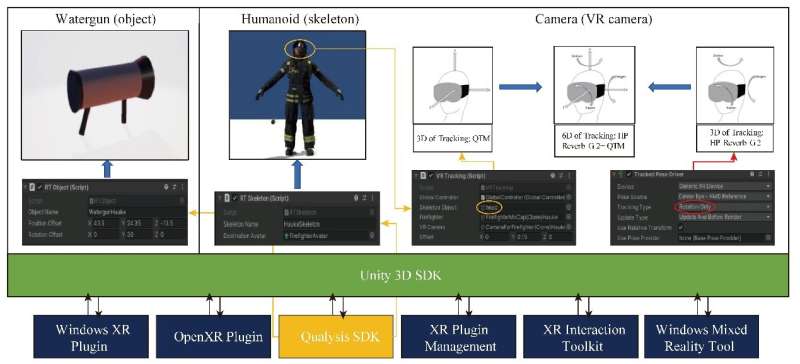This article has been reviewed according to Science X's editorial process and policies. Editors have highlighted the following attributes while ensuring the content's credibility:
fact-checked
proofread
Virtual reality for immersive multi-user firefighter-training scenarios

The main aim of this study was to develop a prototype of a VR application for professional training in disaster management tasks. Because several scenarios can only be trained with limited variability at considerable expense in conventional physical training environments, the need for immersive VR training is becoming increasingly apparent. Moreover, virtual training offers the possibility of representing hazardous environments with minimal risk. Existing virtual training applications lack the combination of multi-user team training and virtual full-body representation of all training participants.
The objectives of this study were thus to identify and describe a training scenario and integrate VR motion capture. This was conceptually outlined and implemented in the prototype. The training scenario addressed disaster management situations in a maritime context. The implementation focused on the interaction in a multi-user scenario and described the synchronization of the VR environments of the training participants and linking of the sensor data. The prototype presented is to be considered as a preliminary work related to extinguishing a fire on a container ship in a VR training scenario.
The preliminary findings and insights from the qualitative tests should be addressed in future research. Comprehensive user tests are planned to assess the impact of virtual training technologies on the professional education of firefighters. In addition, the ergonomic factors should be evaluated. Thus, the usability of the system in practical training procedures must be determined. To increase the training effect, particular attention should be paid to the indicators of trainee-based evaluation, such as cybersickness, task performance, cognitive states, and usability. These user tests are planned to be executed in cooperation with firefighters and experts in maritime disaster management operations.
To use the developed system for completing training procedures for operative firefighters with a maritime background, the present training scenario must be expanded. The current scenario covers only a limited use case and offers the possibility of extinguishing a single fire inside a sea freight container and virtually navigating aboard the simulated cargo ship. In the future, more extensive training scenarios, more complex tasks, assets, tools, and diverse hazardous situations should be covered (e.g., toxic hazards and medical emergencies).
Therefore, in subsequent work, the training scenario should be extended and validated in cooperation with experienced firefighters to implement a realistic training sequence. Furthermore, a measurement model must be developed to measure the training progress of participants. Measuring the fitness values of training participants, such as the pulse rate, is possible. Furthermore, the suits may be heated by heating elements in the future to simulate temperature changes and force feedback.
From a technical perspective, further development steps should address the tracking stability. The problems resulting from the occlusion of motion-capture markers must be mitigated. This can be achieved by employing an adjusted setup with additional motion-capture cameras or by integrating IMU sensors.
More information: Philipp Braun et al, Virtual Reality for Immersive Multi-User Firefighter Training Scenarios, Virtual Reality & Intelligent Hardware (2022). DOI: 10.1016/j.vrih.2022.08.006





















